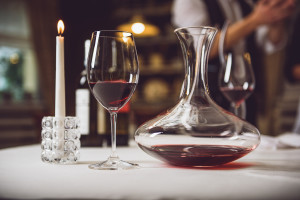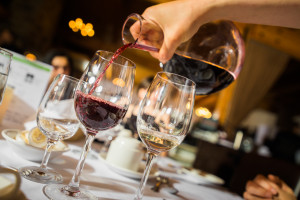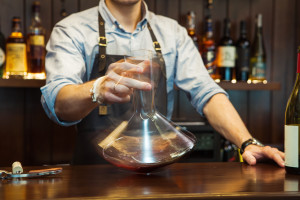Today we have a preview of a session to be presented during SWE’s 42nd Annual Conference, to be held on August 15–17, 2018 in the Finger Lakes Region of New York State. Our guest author is David Davoust, CSW, who tells us about his upcoming session entitled Decanting: What, When, Why, and How:
So…what’s happening in the glass?
The wine industry has spent millions of dollars researching what is happening in the bottle. How much sulfur? How much air? How much residual sugar? How much acid? Destem or add that tannic kick? What type of enclosure do you need? How do you age the wine? How do you store it? The list goes on. And the industry has analyzed and tested and tasted to try to get the optimal experience out of a bottle of wine.
But what about after the bottle has been opened? The research seems to have stopped. Nobody has been paying attention to how to get the optimal experience out of a glass of wine. We do a few things, of course: we chill or let warm; we aerate; we decant; we swirl; we wait. But why and when should we do each of these things?
What started as a simple question of how do you know whether or not to decant any particular bottle has led to some very interesting original research. We wanted to know what is actually happening in the glass (or decanter) once the wine leaves the bottle. As wine specialists, educators, sommeliers and wine drinkers, could it not enhance our own experiences and our education of others if we know exactly what chemical processes are happening to the wine in the glass and how that affects the perceived taste or enjoyment?
We set out to answer these questions with a two-pronged approach. First, we are doing chemical analysis of wine samples at various times after opening: right out of the bottle, aerated, left open and decanted for various periods of time. Chemically, we know some of what oxygen does when it hits wine. But what about the other transformation and evaporation of alcohols, acids and phenolics? We are using both our own lab (cash stills, etc.) to analyze, but then we are also using commercial labs that can better test for the more hidden effects such as what is happening to the phenolics during that process.
Second, we are doing experiential analysis through blind surveys of wine drinkers. Each group is provided 4 to 8 wines without knowing anything about the test. We have them rate each wine on perceived sweetness, acidity, tannins, mouthfeel, aroma, and taste preference as related to the other wines in the sample. The results so far have been surprising but pretty consistent.
The combination of these tests is providing some great insights into how to get the best out of each glass of wine after the bottle has been opened. The initial results of this research will be presented during the “Decanting: What, When, Why, and How” session, to be offered on Wednesday, August 15th at 2:45 pm as part of the 42nd Annual Conference of the Society of Wine Educators, to be held in the Finger Lakes Region of New York State.
About the presenter: David Davoust is an author, educator, researcher and Certified Specialist of Wine. He serves as the wine director for private wine pairing dinners and is currently working on an educational series called, “Wines With a Story™”.


